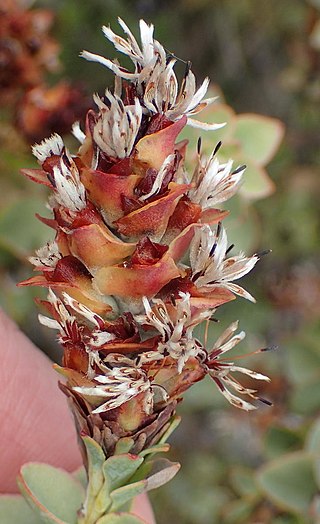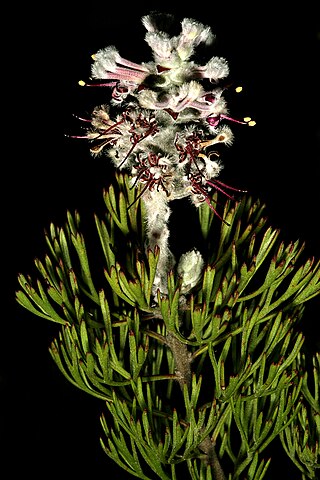
Paranomus is a genus of 18 species of flowering plants, commonly known as "sceptres", in the protea family. It is endemic to the Cape Floristic Region of South Africa.

Paranomus abrotanifolius, commonly known as the Bredasdorp sceptre, is a richly branching shrub to 90 cm (35 in) high, with bisexual flowers that can be found from May to December, that is assigned to the protea family. It does not survive the periodic wild fires that occur in the fynbos, where it occurs. It is pollinated by insects. The fruits are ripe and release the seeds about two months after flowering, and the seeds are collected by ants, which take them to their underground nests to feed on their elaiosomes, a behaviour known as myrmecochory. This ensures that the seeds do not burn, so new plants can grow from them. It is a rare endemic species that is only known from ten locations near the southern coast of the Western Cape province of South Africa. It grows on weathered sandstone on the Potberg in De Hoop Nature Reserve and the Elim Flats.

Aulax umbellata, the broad-leaf featherbush, is a shrub native to the Western Cape. It occurs on the lower slopes and coastal lowlands from Kogelberg to Mossel Bay up to altitudes of 500 m. The shrub grows with a single stem and grows up to 2.5 m tall. Umbellata means like an umbrella. The leaves have rounded tips and can become 110 mm long and 15 mm in diameter. The plant is bisexual, male and female flowers grow on different plants. The plants bloom from September to February. A variety of insect species help pollinate the plants. Female flowers dry out and form a woody shell in which the seeds are formed and preserved. Fires destroy the plant and only the seeds survive.

Serruria fucifolia, the northern spiderhead, is a flower-bearing shrub that belongs to the genus Serruria and forms part of the fynbos. The plant is native to the Western Cape, South Africa.
Paranomus adiantifolius, the hairy-style sceptre, is a flower-bearing shrub that belongs to the genus Paranomus and forms part of the fynbos. The plant is native to the Western Cape, South Africa.

Paranomus dregei, the scented sceptre, is a flowering shrub belonging to the genus Paranomus. The plant is native to the Western Cape, South Africa.

Paranomus bracteolaris, the smooth-leaf tree sceptre or Bokkeveld sceptre, is a flower-bearing shrub that belongs to the genus Paranomus and forms part of the fynbos. The plant is native to the Western Cape and Northern Cape, South Africa.

Paranomus longicaulis, commonly known as exploding baked apple and woolly sceptre, is a flower-bearing shrub that belongs to the genus Paranomus and forms part of the fynbos. The plant is native to the Western Cape where it occurs on the eastern Langeberg from Garcia Pass to the Attakwaskloof.

Paranomus roodebergensis, also known as the honey-scented sceptre, is a flower-bearing shrub that belongs to the genus Paranomus and forms part of the fynbos. The plant is native to the Western Cape, South Africa.

Paranomus spathulatus, the Langeberg sceptre, is a flower-bearing shrub that belongs to the genus Paranomus and forms part of the fynbos. The plant is native to the Western Cape, South Africa.

Paranomus bolusii, the Overberg sceptre or viking sceptre, is a flower-bearing shrub that belongs to the genus Paranomus and forms part of the fynbos. The plant is native to the Western Cape, South Africa.

Paranomus centaureoides, the Ladismith sceptre, is a flower-bearing shrub that belongs to the genus Paranomus and forms part of the fynbos. The plant is native to the Western Cape, South Africa.
Paranomus candicans, the powder sceptre, is a flower-bearing shrub that belongs to the genus Paranomus and forms part of the fynbos. The plant is native to the Western Cape, South Africa.
Paranomus lagopus, the rabbit-paw sceptre, is a flower-bearing shrub that belongs to the genus Paranomus and forms part of the fynbos. The plant is native to the Western Cape where it occurs in the Koue Bokkeveld Mountains, Groot-Winterhoek Mountains and Elandskloof Mountain.
Paranomus reflexus, the Van Staden's scepter, is a flower-bearing shrub that belongs to the genus Paranomus and forms part of the fynbos. The plant is native to the Eastern Cape where it occurs on the Elandsberg and Van Stadensberg.
Paranomus capitatus, the fine-leaf sceptre, is a flower-bearing shrub that belongs to the genus Paranomus and forms part of the fynbos. The plant is native to the Western Cape where it occurs in the Du Toits Mountains south of Du Toitskloof Pass to the northern slopes of the Riviersonderend Mountains.

Paranomus dispersus, the long-head sceptre, is a flower-bearing shrub that belongs to the genus Paranomus and forms part of the fynbos. The plant is native to the Western Cape, South Africa.
Paranomus esterhuyseniae, the Kouga sceptre, is a flower-bearing shrub that belongs to the genus Paranomus and forms part of the fynbos. The plant is native to the Western Cape where it occurs in the Kouga Mountains and Outeniqua Mountains.

Paranomus tomentosus, the hairy-leaf tree sceptre, is a flower-bearing shrub that belongs to the genus Paranomus and forms part of the fynbos. The plant is native to the Western Cape, South Africa.
Paranomus spicatus, the Kogelberg sceptre, is a flower-bearing shrub that belongs to the genus Paranomus and forms part of the fynbos. The plant is native to the Western Cape where it occurs in the Hottentots Holland Mountains from Sir Lowry's Pass to Kogelberg.


















